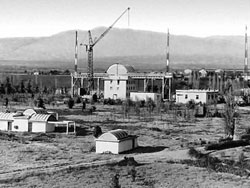History

The first known record of Dushanbe dates back to the XVII century. In the sources it`s called as kasabai Dushanbe, which reflects its city status. But as shown by numerous recent finds of archaeologists, ethnographers and historians made in the territory of modern Dushanbe, the age of the city is much older. In the area of Putovskoy slope were found remains of settlements of the Greco-Bactrian Kingdom (the end of the III BC.), and the site of ancient settlement of Kushan period (VII-VIII) on the left bank of the river Dushanbinka. This is the evidence of that almost 2500 years ago, this area was inhabited, and there existed a high culture of craft and town planning.
Before the revolution of 1917, on the territory of the current capital of Tajikistan were three small villages Sari Assia, Shahmansur and Dushanbe. Dushanbe, which means Monday in Tajik, developed on the site of a Monday marketplace village, Dyushambe-Bozor,and its former name Dyushambe was a Russified version of the word meaning Monday in Tajik. It occupied a favorable location at the crossroads of caravan routes, which linked the Hissar valley with Bukhara and Samarkand, the Pamirs and Afghanistan. Later, it united with Sari Assia and Shohmansur kishlaks.
In 1920, the last Emir of Bukhara Side Alimhon, who escaped from Bukhara, made Dushanbe his residence. After 4 months under the pressure of the Bolsheviks, he was forced to leave Dushanbe and flee abroad. At the end of 1921 more than 10 thousand Bassmaches led by Enver Pasha, laid siege to Dushanbe. The Bolsheviks defended until the middle of February 1922. But because of lack of food and ammunition, they had to retreat. Nevertheless, on July 14, 1922 Dushanbe again passed into the hands of the Bolsheviks. Untill 1929, the city is officially called Dyushambe in Russian, in 1929 Dushanbe was renamed Stalinabad, after Stalin and carried this name for 30 years. During this period, in Dushanbe started a rapid growth, there appeared the first paved street, mill, soap, oil and cotton- cleaning factories, metal-mechanical and joiner`s workshops. In the same year in the Tajik capital, were opened a movie studio and the first documentary, created at this studio, captured coming into the city, the first train from Termez on the railroad built in 1929. This gave impetus to the development of the textile, electrical and food industries, as well as engineering. In 1938 was developed the first general plan of the city with a population of 170 thousand people.
For 76 years the village, lost among the mountains, turned into a modern industrial city. From 1929 to 1990 it was the capital of Tajik Soviet Socialist Republic, and from 1991 - the center of political, economic and cultural life of the sovereign state, the Republic of Tajikistan.